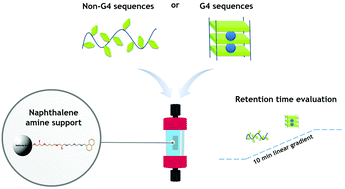Naphthalene amine support for G-quadruplex isolation†
Abstract
G-quadruplex (G4) is involved in many biological processes, such as telomere function, gene expression and DNA replication. The selective isolation of G4 using affinity ligands that bind tightly and selectively is a valuable strategy for discovering new G4 binders for the separation of G4 from duplexes or the discrimination of G4 structures. In this work, one affinity chromatographic support was prepared using a naphthalene amine as a G4 binder. The ligand was immobilized on epoxy-activated Sepharose CL-6B using a long spacer arm and was characterized by HR-MAS spectroscopy. The supercoiled (sc) isoform of pVAX1-LacZ and pVAX1-G4 was isolated from a native sample. Also, the recovery and isolation of the plasmid isoforms from Escherichia coli lysate samples were achieved using an ionic gradient with different concentrations of NaCl in 10 mM Tris-HCl (pH 7.4). The retention times of different DNA/single strand sequences that can form G4, such as, c-MYC, c-kit1, c-kit2, tetrameric, telomeric (23AG), thrombin aptamer (TBA) and 58Sγ3 in this support were evaluated. Our experimental results suggest that the support exhibits selectivity for parallel c-MYC and c-kit1 G4s. In vitro transcription was performed using purified sc pVAX1-G4 and pPH600 to induce G4 formation and circular dichroism (CD) analysis confirmed that both transcripts adopt a parallel G4 topology.



 Please wait while we load your content...
Please wait while we load your content...